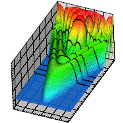Department of Physics and Astronomy: Publications and Other Research

Anthony F. Starace Publications
Document Type
Article
Date of this Version
March 1985
Abstract
A comprehensive theoretical treatment is presented for the electron detachment cross section, differential in both electron momentum and direction, for collisions of 0.5-MeV H- projectiles on He targets. Our calculation, which assumes that the residual H atom is left in the 1s state, employs the usual first Born approximation as well as the closure approximation (in order to sum over all He target final states). Electron correlations within the H- system are treated in detail within the framework of the adiabatic hyperspherical coordinate approximation. In particular, for the first time for this collision process, angular correlations are included. The s, p, and d partial-wave components of the detached electron hyperspherical coordinate wave function are also included. The helium target is described by the atomic form factor and the incoherent scattering function tabulated by Hubbell et al. as well as by an average He excitation energy, I-He. The prescription of Lee and Chen for I-He, which for small scattering angles gives the value 35 eV is found to result in the best agreement of our calculated doubly differential cross sections with experiment, both in shape and in predicted peak energies. The unique feature of the experimental doubly differential detachment cross section of Menendez and Duncan, that for electron-scattering angles less than 4° there is a double peak, is reproduced in our calculations. However, the predicted higher-energy peak is smaller in magnitude and higher in energy than that observed experimentally. This difference is attributed to the influence of excited H-atom states, which are measured in the experiments. Fictitious calculations are carried out for the doubly differential cross sections in which the s-wave electron phase shift is fixed at zero radians instead of its true monotonically decreasing value with increasing electron energy from the value π at threshold. These fictitious calculations demonstrate the disappearance of the double-peak structure of the cross section and confirm the origin of the double peak in the s- and p-wave interference and in the initial π phase shift of the s partial wave. Though our single differential cross sections differ quantitatively from previous calculations of Maleki and Macek, the approximate factor of 2 discrepancy between the theoretical predictions and the absolute experimental measurements remains unexplained.


Comments
Published by American Physical Society. Phys. Rev. A 31, 1336 (1985). http://pra.aps.org. Copyright © 1985 American Physical Society. Permission to use.